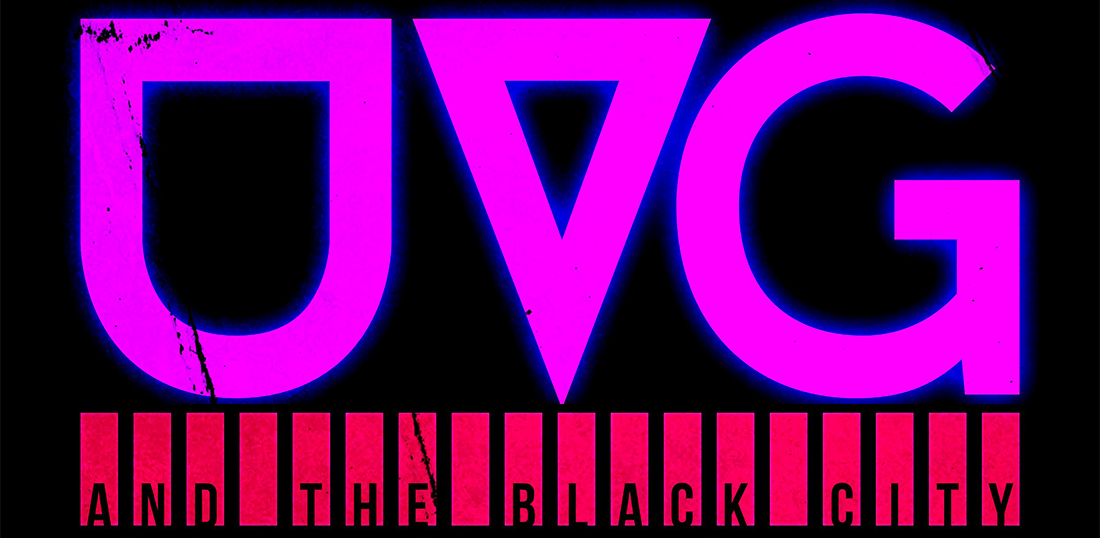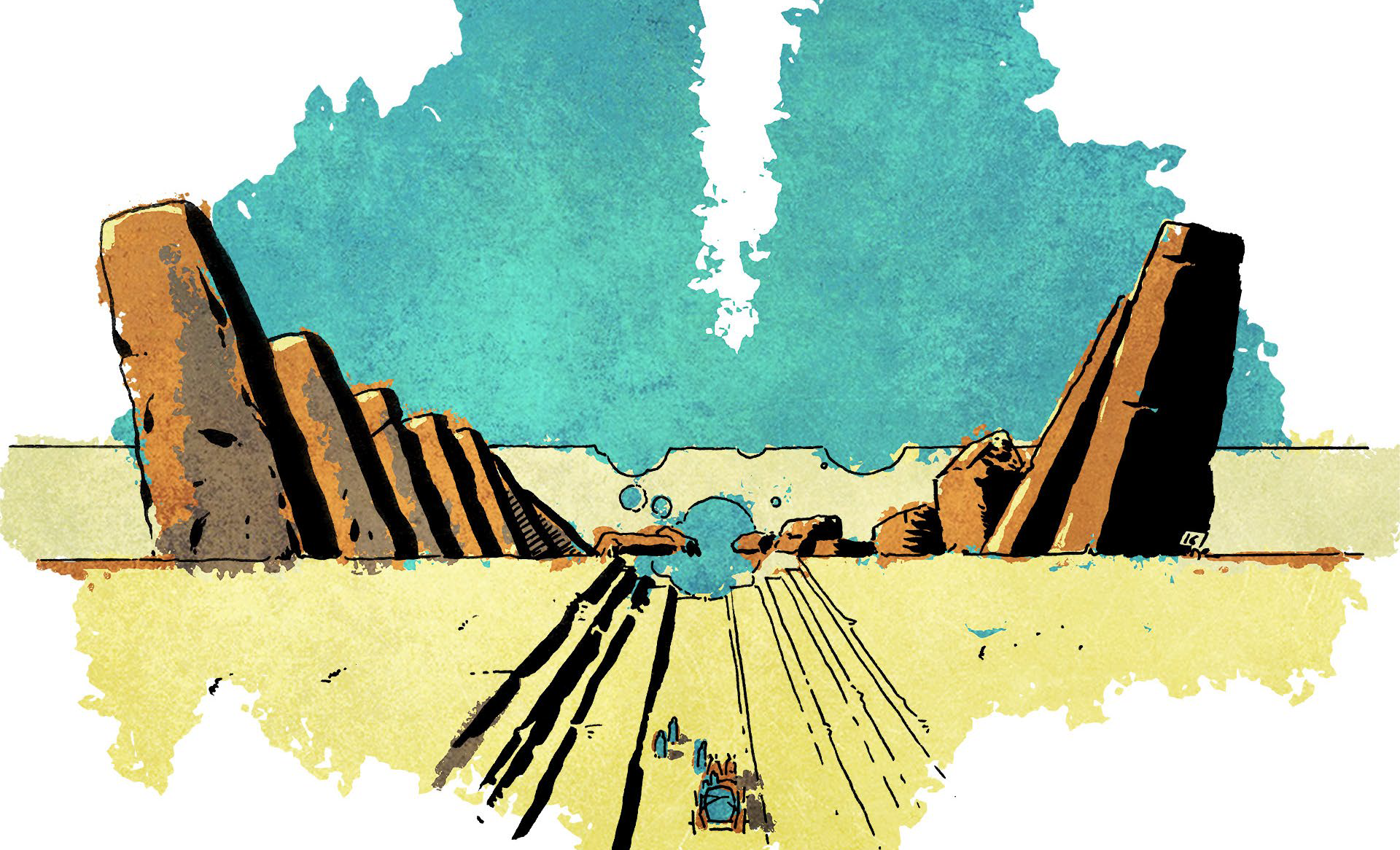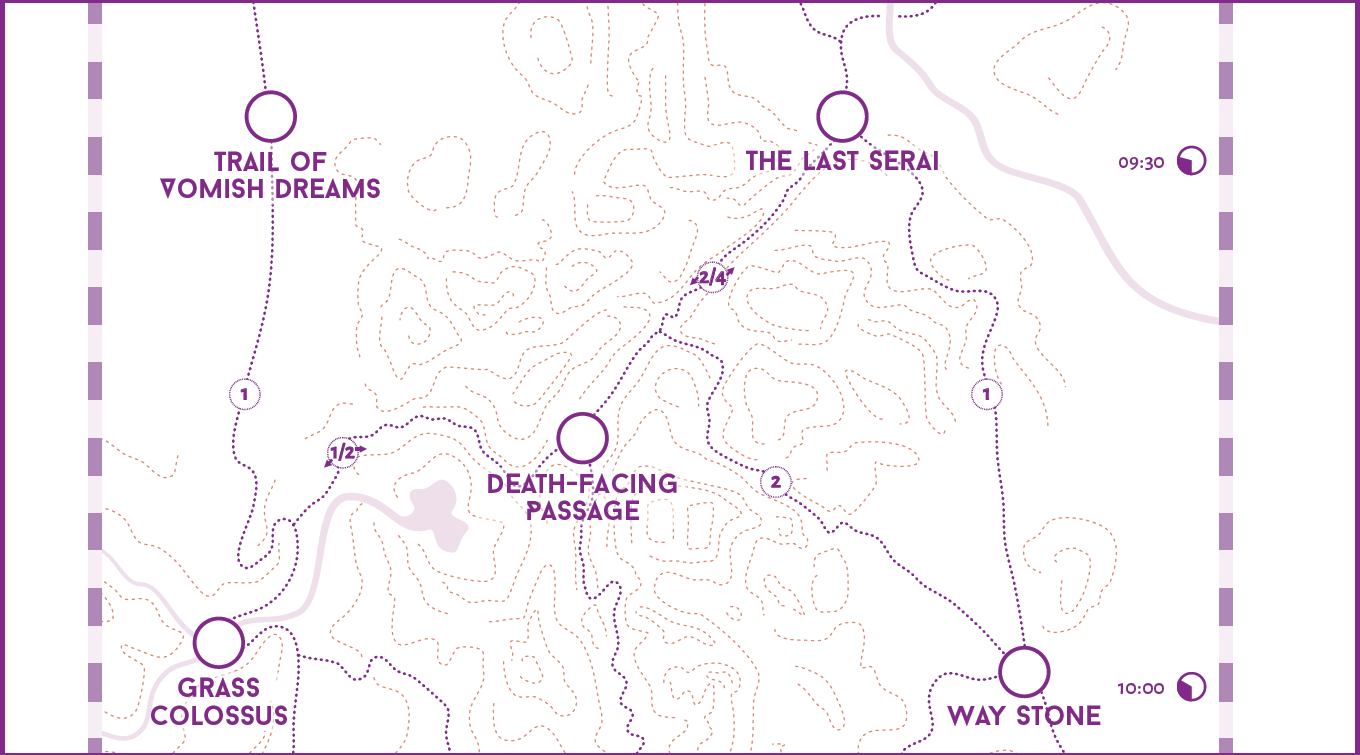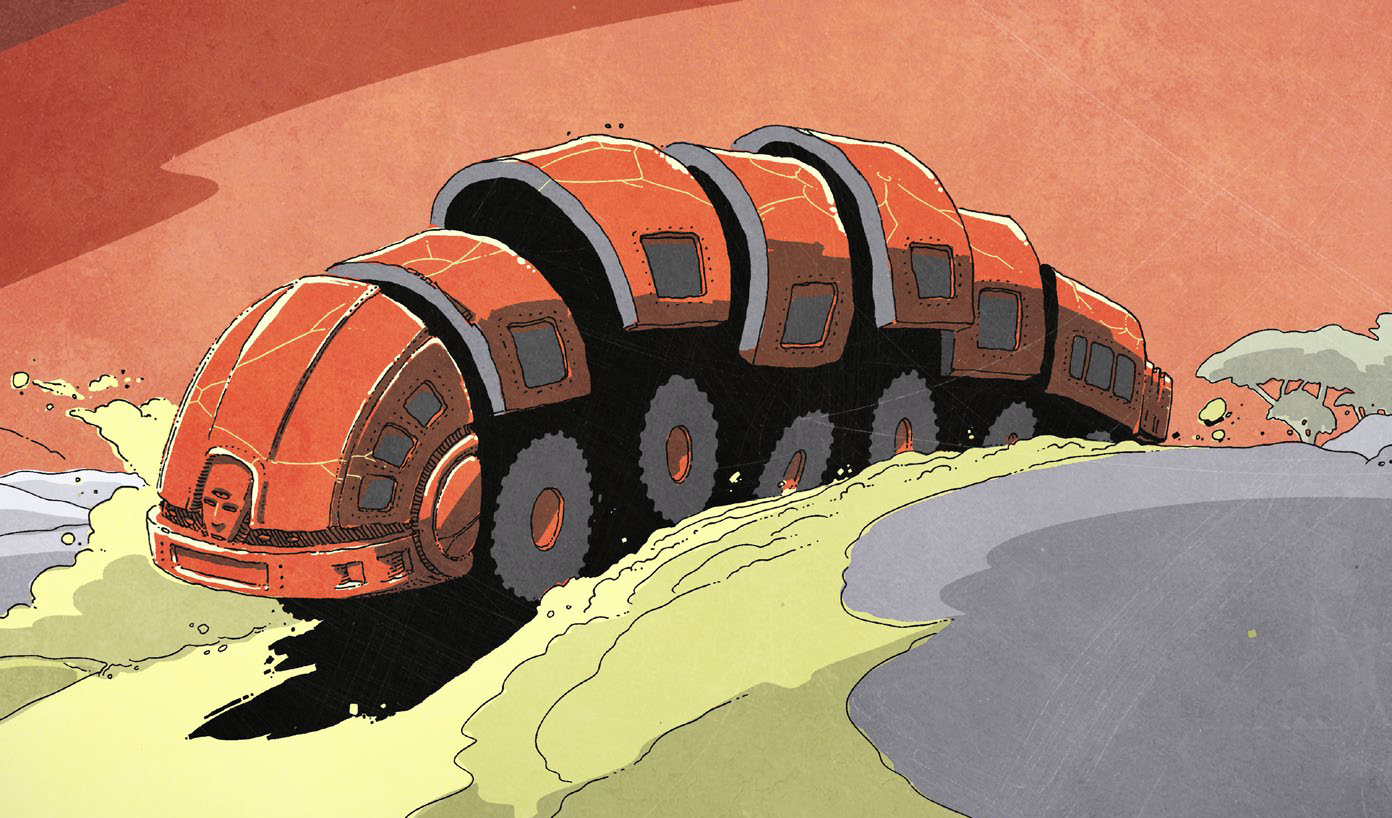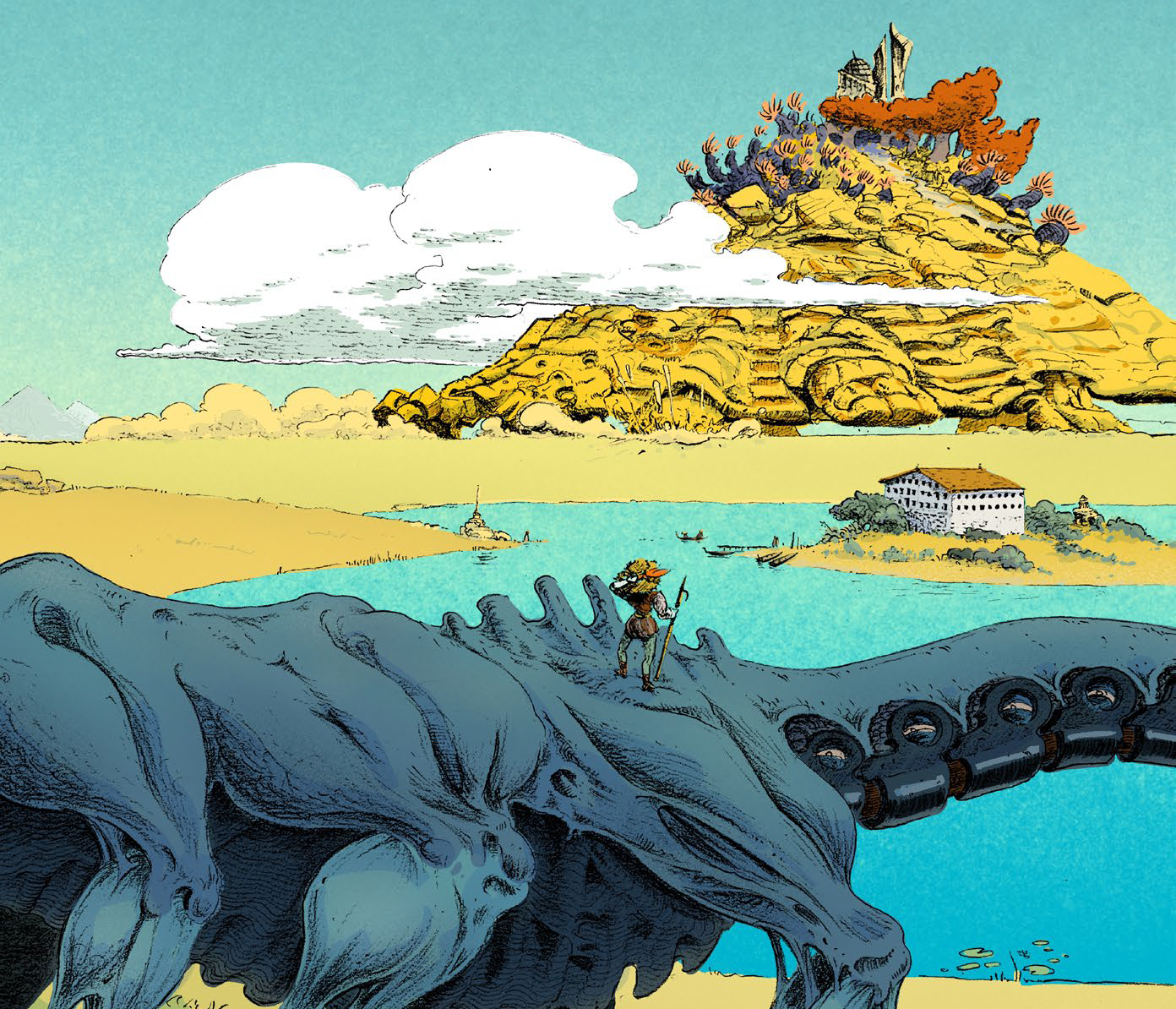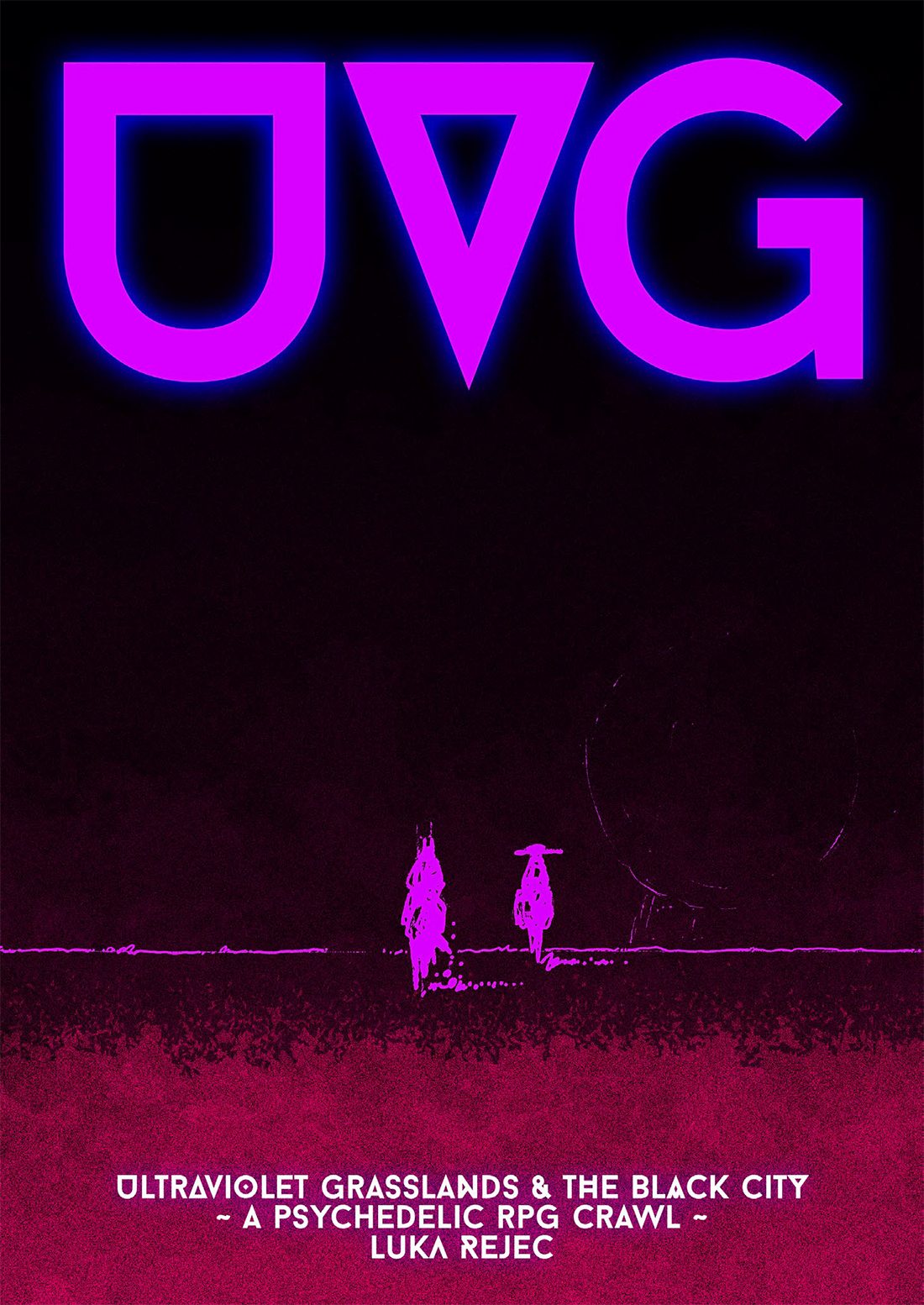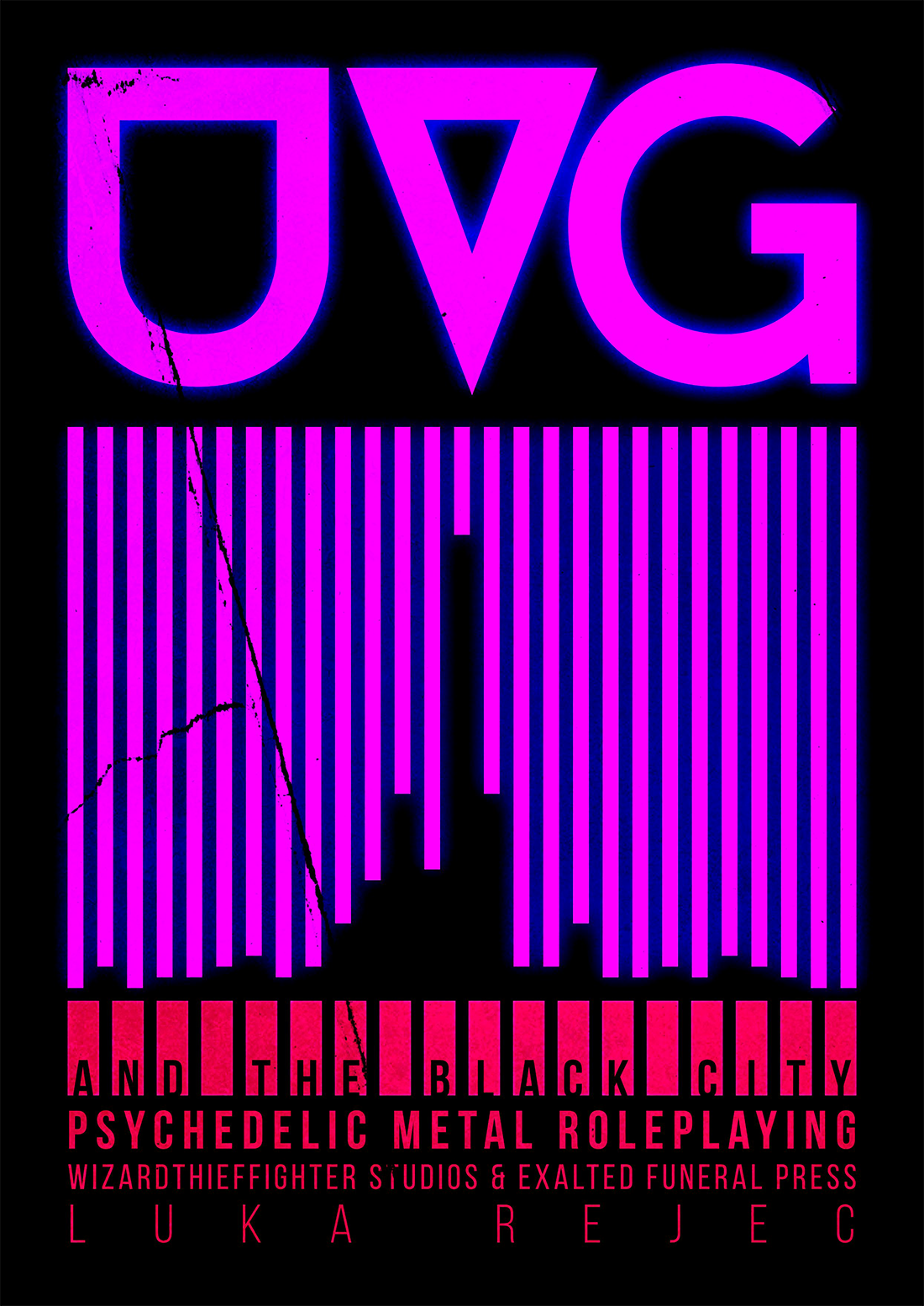The Ultraviolet Grasslands (UVG) is a caravan-crawl campaign designed by Lukas Rejec. If you’re not already familiar with UVG, this whole post will probably make more sense if you read my review of the setting first.
Short version: There’s a network of nodes. Each node (or destination) is a potential market where PCs can buy or sell trade goods. One form of play in the caravan-crawl is discovering profitable trade routes between destinations (where you can buy a trade good at a low price in one destination and then sell it at a high price in another destination).
The PCs can use market research to determine the prices for trade goods. UVG has two different systems for market research: One described in the free PDF Ultraviolet Grasslands: Introduction and another in the full-fledged Ultraviolet Grasslands and the Black City.
UVG INTRODUCTION – MARKET RESEARCH
In the Introduction system, PCs can spend 1 day learning the price of a trade good in an adjacent location or 1 week to figure out the price of trade goods in up to three chained locations. For each location, they make a market check sing an appropriate skill and the result determines the price factor for that location (e.g., a result of 8 gives a price factor of 1 for the location; a result of 17 gives a price factor of 1.5). You multiply the base cost of the trade good by the price factor to determine how much it sells for in that location.
There are two things I like about this system:
- It’s simple and straightforward. Almost effortless.
- It requires zero prep. In fact, it’s specifically designed to be used during play, generating only those results which are relevant to the PCs.
The problem with the system is that the prices are dependent on the PCs’ skill check. At the most trivial level, this means that as the PCs increase their skill bonuses, prices will inflate across the grasslands. You’ll also get some weird plateauing effects where certain chart results drop below the minimum possible result.
UVG & THE BLACK CITY – MARKET RESEARCH
At first glance the system in Ultraviolet Grasslands and the Black City appears fairly identical to that from the Introduction. In practice, however, the system has received several tweaks which, speaking frankly, are almost entirely to its detriment.
First, a cash cost has been added to the time cost of market research. This is just fine and the intention is to probably discourage PCs from simply camping out in a “safe” destination and just grinding out market research.
Second, although the system still allows the PCs to focus their market research on a specific destination (or destinations), it can now produce results like, “Three stops away a place pays x4.” This seems fine, but in practice it muddies things up considerably by creating non-specific results. In addition, since there’s no way to directly generate these x4, x5, and x6 results for a location directly (only at a distance), the system inadvertently incentivizes the PCs to NOT explore the caravan routes and instead grind market research in the locations closest to Violet City (their origin point) in the hope of generating high reward locations as close as possible.
Third, key results are now seeded onto the results table, which makes the plateauing problem a lot worse. For example, a result of 7 determines that the location produces the trade good in question. That means anyone with a +7 skill check modifier will no longer generate locations that produce trade goods, completely warping the trade map. (How soon could that happen? Theoretically, a 2nd level character.)
Fourth, they accidentally broke the system. The Introduction system could indicate that the trade good could not be sold in a particular destination (generally due to the market being saturated with local products), but indicated that the price factor in these locations was still 1 (meaning that the PCs could buy the trade goods there at their base price).
In the Black City system, these scenarios are instead modeled with a price factor 0. But remember that you multiply the price by the price factor, so a price factor of 0 means that the price will also be 0. So, for example, you can get a result of, “But they produce it here. New source, cool.” paired to a price of 0. (And it’s unclear whether that means you can’t buy it even though it’s a new source, or if they’re just giving it away for free. But either is broken.)
Note: Now that I’ve spent a considerable amount of time ripping apart one small sub-system of UVG, I do want to take a moment to say that this is no way representative of the overwhelming quality of the book as a whole. (Seriously. Go read my review.) I would not be spending so much time working on such a relatively tiny element if it wasn’t part of a well-oiled machine.
REVISED MARKET RESEARCH
The core problem with the existing market research system is that the PC’s skill check is determining the local market price. Instead, we need to generate the demand separately from the skill check to learn the demand.
- Spend 1 day and make an Easy (7) skill check to determine the market price for a specific trade good in your current location. If you succeed at a Very Hard (18) skill check, you gain advantage on your haggling check (see UVG, p. 176; you’ve found lead that may be more lucrative than the base local price).
- Spend 1 week and make an Easy (7) skill check to determine the market price for a specific trade good in one adjacent location. For every 4 points of margin of success on the check, determine the market price in an additional adjacent location. (These adjacent locations can be built out in one or more chains, with the second being adjacent to the first, and so forth.)
Design Note: I’m using difficulty numbers calculated for UVG. If you’re using 5E, you can translate these to DCs based on the descriptive values (Easy = DC 10, for example).
VARIANT – RESEARCH COST: As noted above, Ultraviolet Grasslands and the Black City added a cost to these actions. You can do the same here: Local research (1 day) costs cash = local expenses. Regional research (1 week) costs cast = 5 x local expenses.
Alternatively, or in addition to this, you could give bonuses to the check if the PCs are spreading cash around. I proposed a similar system for bribing here, and you could basically use the same structure while swapping out “bribe value” for “local expenses” in UVG.
DETERMINING LOCAL PRICE – SIMPLE VERSION
To determine the local price for a trade good, simply roll on this table:
| d20 | Price Factor | Notes |
|---|---|---|
| 1 | 0 | Taboo. Nobody wants it. Reactions to those known to be dealers may be openly or secretly hostile. |
| 2 | 0 | No demand. |
| 3-5 | 0.5 | Low demand. |
| 6-12 | 1 | Normal market. |
| 13 | 1 | Depressed market. Haggling checks are made at disadvantage. |
| 14-15 | 2 | Illegal. Stiff penalties to dealers who are caught. |
| 16-17 | 2 | High demand. |
| 18 | 3 | Bubble market! 1 in 6 chance per caravan visit that market has collapsed (roll 1d8 on this table). |
| 19 | 4 | The motherload! You're really in business! 1 in 6 chance per caravan vist the market has readjusted (roll again on this table). |
| 20 | 1 | Source! They make the trade good here. Haggling checks are made at disadvantage; those to buy are made at advantage. |
VARIANT – MARKET FLUCTUATIONS: Once per month (every 4 weeks) or between each session, check all locations with known market prices. There is a 1 in 10 chance that 1d4 prices in that location have changed. Reroll on the table.
Design Note: You may need to play with the frequency of these tests and/or the rate of change to get a satisfactory result.
DETERMINING LOCAL PRICE – COMPLEX VERSION
… but not ultra-complex.
This system determines prices by establishing the original source(s) for a trade good and then calculating local prices based on the market’s proximity to the source. It is more time-consuming, but I don’t think significantly so.
GENERATE SOURCES: Each trade good has 1d4-1 sources in the Ultraviolet Grasslands. (If there are zero sources in the grasslands, then the Violet City is treated as the source, although most likely because it is being shipped from somewhere in civilization.)
For each source, roll 1d30+1 to generate a random destination (this excludes the Violet City and the Black City).
The price factor of a trade good at its source is 1. Haggling checks to sell are made at disadvantage and haggling checks to buy are made at advantage.
CALCULATE PRICE – EASY VERSION: When the PCs do market research in a location, determine the number of weeks of travel between the location and the closest source of the trade good. The price factor increases by +1 for every two weeks of travel, to maximum of 6.
Design Note: The advantage of this method is that it be done as quickly as you can count spaces on the map. However, it will create a very uniform (i.e., boring) experience. Like a dungeon featuring perfect symmetry, there will be considerably less interest in exploration and market research will be generally devalued.
CALCULATE PRICE – STEPPED VERSION: When the PCs do market research in a location, determine the shortest path between the location and the closest source of the trade good. For each week of travel along this path, modify the price factor by 1d4-2. This cannot reduce the price factor below 1, nor above 5.
SPECIAL MARKETS: 1 in 6 markets will have a special relationship with the trade good. Roll 1d8 on the table:
| d8 | Special Market |
|---|---|
| 1 | They make it here! New source. (For locations closer to the new source than other sources, there is a 1 in 4 chance per month or per visit by a caravan selling the trade good that the local price will adjust to the new source.) |
| 2 | Taboo. Nobody wants it. Reactions to those known to be dealers may be openly or secretly hostile. Price factor is 0. |
| 3 | Taxed. Local authorities skim 1d6 x 10% off transactions... if they know about them. (Under the table deals suffer disadvantage on the haggling check.) |
| 4 | Low demand. Price factor is 0.5. They just don’t care for the stuff here. |
| 5 | High demand. +1 effective price factor. (This can increase the price factor to 6. Ignore this +1 when determining the price factor of the next destination along the route.) 1 in 4 chance per visit that demand has collapsed, reducing price factor by 1d3. |
| 6 | Illegal. +1 effective price factor, but stiff penalties for dealers who are caught. (This can increase the price factor to 6. Ignore this +1 when determining the price factor of the next destination along the route.) |
| 7 | -1 price factor. If price factor at 1, reduce to 0.5. If price factor is already 0.5, reduce to 0. |
| 8 | Roll again twice. |
Design Note: Rolling again twice on this table may create strange combinations. (For example, Taboo + High Demand. Or Illegal + Taxed.) Seize the opportunity to creatively explain the discrepancy. For example, if the goods are illegal, who’s charging the tax? A local crime syndicate? A strange goddess who haunts the village?

